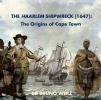The Haarlem Shipwreck (1647): The Origins of Cape Town
Keywords:
Shipwreck, Maritime history, South Africa, VOC, Cape of Storms, Southern Africa, Table Bay, Robben Island, Seventeenth century, Dutch East India Company, Haarlem shipwreckSynopsis
he Haarlem Shipwreck (1647) explores the story around one of the earliest recorded maritime accidents in Table Bay. In this gripping investigation, based on detailed archival research, Bruno Werz chronicles the demise of the ship, and the sojourn of 62 of its survivors on the shores of the bay. These events, seemingly inauspicious, led to the establishment five years later of the Dutch East India Company refreshment station along the trade route, and from these pragmatic arrangements grew the settlement of Cape Town, to become the ‘Mother City’ of the present-day multiracial and multicultural society of South Africa.
This superbly researched book promises to be a source publication with a difference. Readers view transcriptions in 17th-century Dutch of original VOC manuscripts (with translations): such as the survivors muster roll, and letters dispatched with a visiting English ship, the Sun. The prize document of the collection is the hitherto unpublished journal kept by junior merchant Leendert Jansz while stranded on the shores of Table Bay, freshly capturing impressions of the people and surroundings untrammelled by the long telescope of our subsequent experience of history.
ContentsChapter 1: Introduction
Chapter 2:
Historical background
Northwestern Europe during the mid-seventeenth century
The Cape of Good Hope
The VOC, its ships and life on board
A brief history of the Haarlem and the events of 1647–1648
Chapter 3:
The documents
The journal of Leendert Jansz and related documents
The Remonstrantie, Jan van Riebeeck’s Closer consideration and the instructions for the commanding
officers of the ships Dromedaris, Reiger and Goede Hoop.
Comparisons between the archival information and the secondary literature
Chapter 4:
Historical-archaeological research
Dawn of the Haarlem project
The development of a framework
Surveying of the presumed site
The 1995 archaeological investigation and later surveys
Chapter 5: Conclusions
Chapter 6: Transcripts and English translations of the documents


